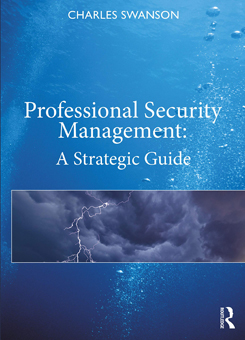Author: Charles Swanson
ISBN No: 9780367339616
Review date: 26/04/2024
No of pages: 299
Publisher: Routledge
Publisher URL:
https://www.routledge.com/Professional-Security-Management-A-Strategic-Guide/Swanson/p/book/9780367339616
Year of publication: 29/07/2020
Brief:
Charles Swanson has done what he says he set out to do; provide a guide to security management, setting out just how wide a field it has to cover – to take his own list, risk and crisis management, continuity management, strategic business operations, data security, IT, and business communications. What he writes, he writes well. Verdict; a considerable achievement.
He covers, besides, Crime Prevention Through Environmental Design (CPTED), counter-terrorism, aviation and maritime security, fraud investigations and retail loss prevention. While from the outset his focus is on the UK, such as the London Olympics, and laws as they apply to Britain (for example for the investigator), he is alive to the subject as applied in the United States and elsewhere.
That may give the impression that Swanson’s book is a gallop through the subject – albeit unavoidable as there is so much to cover. It’s more than that. He wisely sprinkles examples from his decades of experience and cleverly changes the pace of the work, for example by inserting ‘pauses for thought’ and ‘just a moment’ questions. Also, to his credit, he is plainly at ease with and quotes from – without ever getting bogged down in – the academic and scholarly literature on the subject, notably (and a wise choice) Prof Martin Gill’s Handbook.
He does not shy away from going over the real dilemmas for the security manager, such as; ought that manager to focus on protecting the business from harm; or seek to add value, by doing more, by offering advice and input to whatever the aim of the organisation is – in the case of a business, to sell product? On that question, Swanson sees both sides of the argument. Businesses are expecting every facet of the organisation to contribute to its development, including the security function; ‘and of course, that, from a business perspective makes absolute sense. However, it must be remembered that from an operational, tactical and strategic perspective, the core function of any security department is to ensure the safety and security of the assets belonging to the organisation that the security department supports and protects.’
Nor does he shy away from the nitty-gritty of the actual work; such as the security survey (not the same as an audit), that he defines as a ‘comprehensive analysis of a company’s premises, systems, and procedures’; and an ‘opportunity to examine all security systems on site in an effort to understand if they are fit for purpose’.
He admits that as a long-time teacher of level four risk assessment and survey courses, he keeps finding security surveyors without formal qualifications. He is not the only one to find, and to deplore, surveying on the basis of the metaphorical ‘back of a fag packet’. As he adds, that is one of the reasons he was prompted to write this book; to make the case for something better, for a qualified security management profession, on the lines of health and safety risk assessment.
The book has it all; anecdotes and ‘lessons learned’, a breakdown of the job, and an insight into how varied and interesting a security manager’s life can be; and wise words on what the character of a security manager ought to be – such words as honesty, and integrity, even when describing something as changeable as risk (‘honesty is always the best policy’).
Also sprinkled through the book is Exercise Brave Defender, setting you scenarios, such as ‘you are the designated global corporate security manager employed by a multi-national telecommunications company’, Britcom plc. What ought your input be into the firm’s negotiations with the Russian government over a business venture?! What ought your security risk assessment of your company’s London head office look like?! What to do about the loyal but angry customer who turns up at reception? As Britcom is a piece of CNI (critical national infrastructure) what do you do about ransomware? What minimum physical and digital standards should your data centre have? And so on. All worthwhile to get the reader thinking, and showing the variety of the work.
The only quibble with this book could be that on occasion the author wanders off the point, and goes into more detail about particular terrorist groups, or piracy in history, than is necessary or good for the overall flow. The book does not flag or sag, but could have been slightly tighter.
May I second the author’s parting remark that there has never been a better time, as far as education and training are concerned, for the professional security manager of today; ‘and it is incredibly refreshing, as a long-serving member of the industry and as a higher education tutor, to see the increase in numbers of applicants at all levels of education and training’. By this well-written work packed with good sense, the author – a Chartered Security Professional and a Fellow of the Security Institute – is contributing to that ‘better time’.
Table of contents:
1 Private security and the development of the Security Manager
2 Security risk management and strategic business awareness
3 Critical Security Areas
3.1 Security Risk Management
3.2 Crime Prevention through Environmental Design and Situational Crime Prevention
3.3 Physical and Electronic Security Systems
3.4 The Security Survey and Security Audit
3.5 Business Resilience
Risk Management
Crisis Management
Disaster Management
Business Continuity Management
3.6 The Chief Security Officer (CSO) and the Chief Information Security Officer(CISO)
3.7 Cyber Crime
3.8 Critical National Infrastructure
3.9 Terrorism and Counter Terrorism
3.10 Aviation and Maritime Security Management
3.11 Supply Chain Security Management
3.12 Hostile Environment Awareness
3.13 Strategic Business Awareness
3.14 Fraud Investigations
3.15 Retail Loss Prevention
3.16 Workplace Investigations
3.17 Academic and vocational qualifications
3.18 Conclusion
Bibliography
Index.










